Father, Daughter Tell Stories Through Embossed Iron Artworks
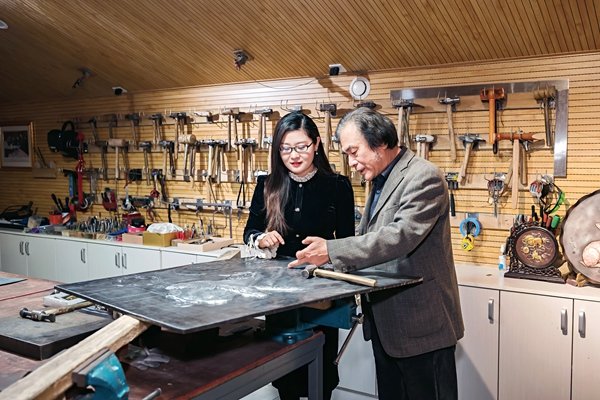
Guo Haibo and his daughter, Guo Mohan, have devoted their lives to the development and inheritance of a traditional Chinese art form — making embossed patterns on iron plates. In 2014 and 2017, Guo Haibo and Guo Mohan were recognized, successively, as inheritors of the provincial-level, intangible-cultural-heritage project — the Guos' craftsmanship of making embossed iron crafts — in North China's Hebei Province. They use their handmade crafts to tell stories about China and, specifically, about Hebei Province.
Embossed iron plates were initially created, as a craft, by Guo Haibo and his brother during the 1980s. The art form is a special type of sculpture, created with iron plates. In 2013, the Guos' craftsmanship of making embossed iron plates was added as a project to Hebei's list of intangible cultural heritage.
Guo Haibo received the title "master of international folk arts" in 2004, so designated by the International Organization of Folk Arts (IOV), under the United Nations Educational, Scientific and Cultural Organization (UNESCO). Guo Haibo is also a "master of Chinese arts and crafts."
His daughter, Guo Mohan, is a provincial-level arts and crafts master, and a recipient of the provincial-level honor of March 8th Red-Banner Pacesetter. She incorporates vitality and creativity into her works. Their family has been named a "most beautiful family," at both the provincial and municipal (Shijiazhuang, capital of Hebei) levels.
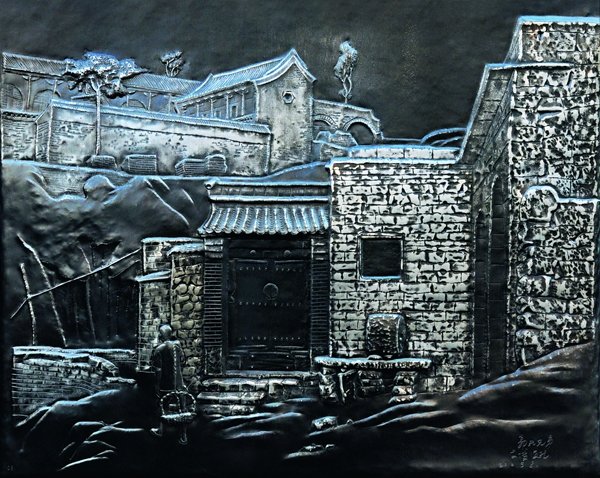 |
| Early morning, by Guo Haibo |
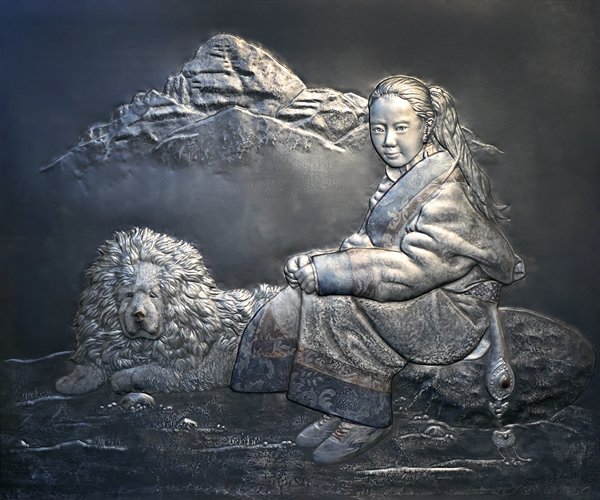 |
| Ganzhu'er, by Guo Haibo |
From Childhood
Guo Haibo began developing his interest in painting when he was young. As he got older, he had various professions, including being a photographer and an editor. He spent much of his spare time drawing and painting. Later, he developed an interest in carving. He began making sculptures out of clay, but eventually realized clay sculptures were easy to break. Over time, he found metal, such as an iron plate, was a more suitable material for making sculptures and other crafts, which could be kept for a much longer time.
After he learned the profound history of iron-made crafts in China, Guo Haibo began exploring methods of utilizing modern techniques to create iron-based crafts. "A lot of memorable moments, in my childhood, were about my father working on iron-made crafts," Guo Mohan recalls, during a recent interview with Women of China.

When he was starting out as a professional artist, Guo Haibo had his studio in a former storage room, which had a mere six-square-meter space. He had to use a quilt to cover the room's window, to reduce the noise so he would not disturb his neighbors. He created crafts in that tiny room, regardless if it was a hot summer day or a chilly winter day.
The little room remained his studio for 10 years, before he moved to another facility about 10 kilometers from the family's home, recalls Guo Mohan. "After having a quick dinner, my father would take me and my mother to the studio, and he would work there often until late at night. He devoted most of his enthusiasm to the art, which gradually earned him appreciation from people working in the field of iron art," Guo Mohan says.
"It is known that while one creates an embossed iron plate, he/she needs another person to help hold the plate. My mother has been the one who has held countless plates, firmly, for my father."
Influenced by her father, Guo Mohan was fascinated by embossed iron plates when she was young. Her life has since involved hammers, chisels and other tools for making such crafts.
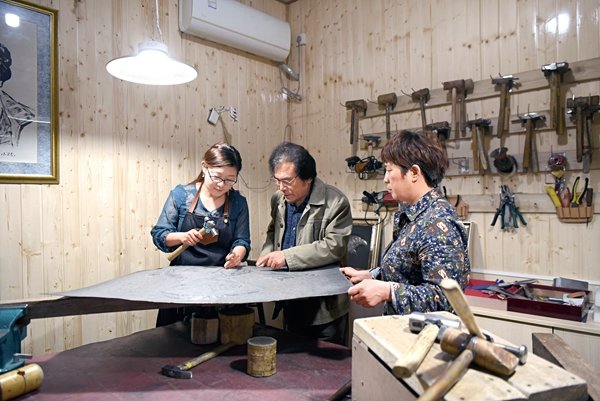
However, Guo Haibo opposed the idea of his daughter becoming a full-time metal-craft artist because he believed the profession would be too challenging — both physically and mentally.
Nevertheless, Guo Mohan told her father of her desire to follow in his footsteps, continuing along the family's path of making iron crafts, after she graduated in 1988 from Guangdong Ocean University, with a major in industrial design. Impressed by his daughter's determination, Guo Haibo accepted her decision, and he began teaching her the techniques used to make embossed iron plates.
Although she found the work challenging, like when she injured her hands while working with a hammer, Guo Mohan never considered giving up. With support and guidance from her father, Guo Mohan gradually grasped the skills needed to complete iron-based crafts. Guo Mohan is one of very few women artists who have mastered the techniques used to make embossed iron plates. Many of her artworks have received State-level and/or provincial-level prizes.
Guo Mohan was a torchbearer during the torch relay of the Beijing 2022 Winter Olympics. During the event, she explained how she had made an embossed iron plate for the Winter Olympic Games. "My work's title, 'Chao Yue,' means 'surpassing.' I have a dream — to have the Chinese art of embossed iron plates go global. It is such a 'hard' Chinese art form, which needs to be better recognized by the world," she says.
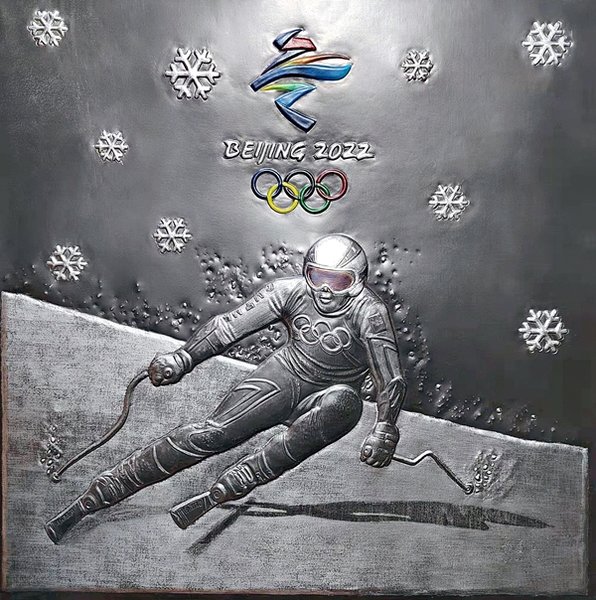 |
| Surpassing, by Guo Mohan |
From Generation to Generation
At the invitation of Hebei Vocational University of Industry and Technology (HBCIT, formerly Hebei College of Industry and Technology), Guo Haibo and Guo Mohan established an art gallery on the campus in July 2018, to promote the protection and inheritance of embossed iron plates. Guo Haibo was hired as a guest professor, and his daughter, a full-time teacher. By teaching the techniques used to make iron crafts, they have helped foster the spirit of craftsmanship among college students.
The gallery has an exhibition area, a work studio and an educational base. Guo Mohan has introduced classes, both public and optional courses, related to the protection and inheritance of embossed iron plates. She and her students have organized various activities to introduce the art of embossed iron plates to students of primary and secondary schools, as well as to residents of neighboring communities.
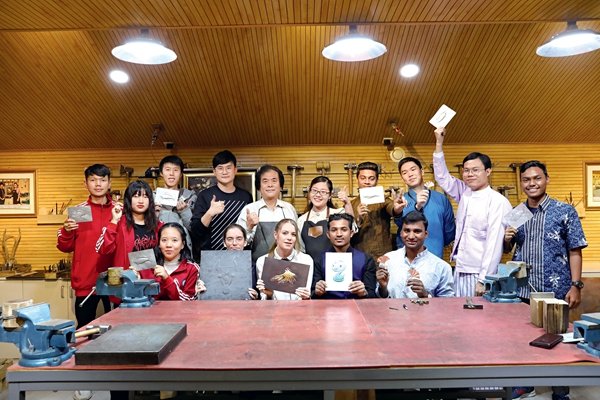
Through years of development, the gallery has become a platform for international students and visiting teachers to learn about and appreciate the charms of Chinese iron crafts. The students and teachers come from various countries, including Bangladesh, Malaysia, Indonesia, Myanmar and Thailand. Some are from European and American countries.
Guo Mohan and her parents have devoted themselves to inheriting and promoting traditional Chinese culture, in part by developing the art form of embossed iron plates. During their spare time, the family uses their studio to organize cultural activities, which enrich the spiritual lives of area residents. Guo Haibo and Guo Mohan — representing two generations of their family — constantly draw inspiration from their daily lives. They create vivid works of art to convey the simple and sincere emotions and dreams of ordinary Chinese.
Photos from Interviewees
(Women of China English Monthly September 2024)
Editor: Wang Shasha
Please understand that womenofchina.cn,a non-profit, information-communication website, cannot reach every writer before using articles and images. For copyright issues, please contact us by emailing: website@womenofchina.cn. The articles published and opinions expressed on this website represent the opinions of writers and are not necessarily shared by womenofchina.cn.








.jpg)

 WeChat
WeChat Weibo
Weibo 京公网安备 11010102004314号
京公网安备 11010102004314号